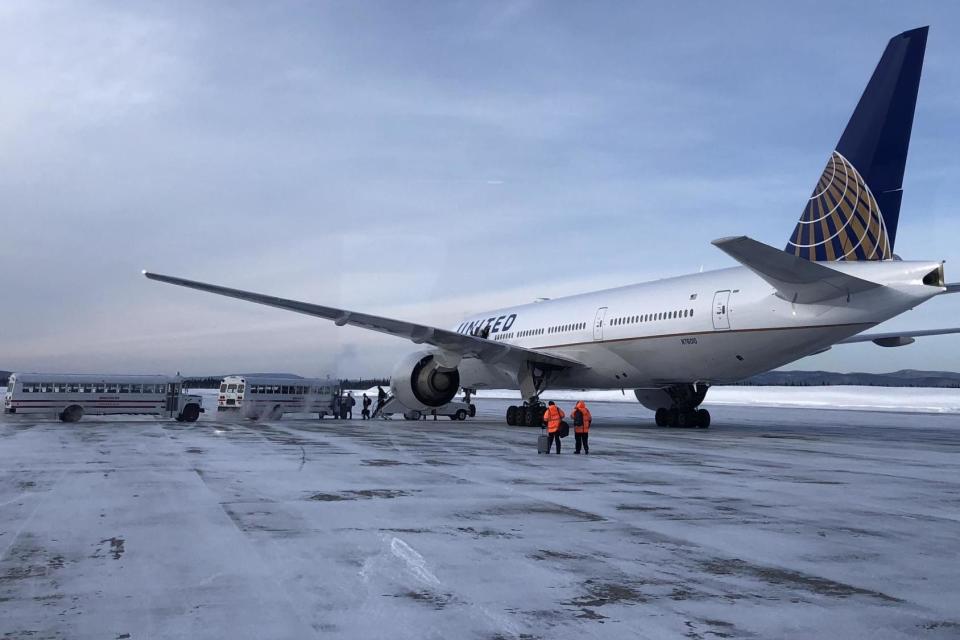United Airlines’ 26-hour flight via the Arctic: What really happened
More has emerged about the causes and consequences of the 16-hour grounding in northern Canada of a United Airlines flight from New York to Hong Kong.
As The Independent revealed, Saturday’s United flight 179 was partway into its journey across the Arctic when the flight crew decided to divert to Goose Bay, Labrador, because of a medical emergency.
A passenger reportedly had seizures within 45 minutes of takeoff. An appeal was made for medical professionals on board. The pilots initially decided to continue, but while the aircraft was off the coast of Greenland the traveller’s condition worsened and they opted to divert to the Canadian military base.
After the Boeing 777 landed, the passenger was taken to a local hospital.
But a door used during the evacuation could not be closed – apparently because it jammed in the extreme cold. The outside temperature was as low as -45C with wind chill, according to a warning from Environment Canada.
The 250 passengers spent the next 16 hours on the ground aboard the 20-year-old plane as they waited for another jet to rescue them. They were not allowed to leave the aircraft because immigration staff were not available in sufficient numbers.
They were told that it would take seven hours to process everyone on board to enter Canada, and that once the procedure had begun it could not be interrupted.
Once the delay became apparent, passengers say they were told a rescue plane was on its way. In fact, the replacement aircraft did not leave Newark until they had been on the ground for 11 hours.
During the delay, one passenger, Steven Lau, tweeted regularly. Near the start of the wait, he wrote: “Never a good sign for your flight when the plane has been sitting on the tarmac for 2+ hours and the pilots are in the cabin taking suggestions from nearby passengers about how to close/arm the emergency exit door.”
There were rumours they would be flown to Vancouver, which would take them closer to their destination of Hong Kong.
Later, as confusion increased over what was being done to solve the problem, a passenger tweeted: “We’ve reached the point where the captain of UA179 has started qualifying all the updates he provides over the intercom with ‘they tell me’, ‘according to them’, ‘supposedly’, etc. (presumably because his @United superiors continue to change their story about what’s happening).
“Google Maps tells me I could walk to New York in about 20 days, so keeping that option open.”
The rescue aircraft finally arrived after 14 hours, with mechanics on board. It could not continue to Hong Kong because of the extreme duration of the flight – 16 hours in normal circumstances – added to the time spent on the ground.
Efforts continued to fix the faulty door so passengers would not need to transfer from one plane to another. But they were eventually moved using school buses.
The replacement plane departed at 4.16pm local time (3.16pm New York time), almost 24 hours after the start of the original flight.
The new aircraft was supposed to have food on board, but another passenger, Chris Liew, said: “Didn’t have a meal or even sandwiches on the flight. Pretty sad.”
As he left, he took a photograph which he captioned: “Our igloo for 16 hours.”
The replacement aircraft touched down at 6pm New York time at Newark airport, where passengers had begun their journey more than 26 hours earlier.
Passengers were handed a letter from Bryan Stoller, United’s vice president of customer care. In it he said, with some understatement: “We did not deliver in providing you a seamless and comfortable travel experience.”
They were offered a choice of a $500 (£388) voucher for future travel on United, or 25,000 MileagePlus points, and were also given a full refund of their fare for the New York-Hong Kong trip. It is understood this will be provided regardless of whether they continue the journey to Hong Kong.
Since they arrived at Newark airport in New York in the evening, they were offered meals and a hotel stay in the city.
The original aircraft is still on the ground in Goose Bay.
The cost to United Airlines of the incident is likely to exceed $1m (£778,000) – made up of lost fares, compensation, care packages, fuel and navigation charges.



